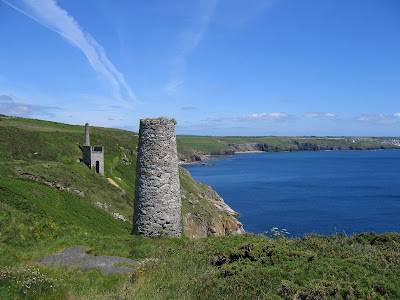 It is possible to walk the entire length of the Cornish coast (and many other areas around the British Isles) on a glorious coastal footpath. The path is a combination of National Trust property, private property with public access, nature preserves and farm land.
It is possible to walk the entire length of the Cornish coast (and many other areas around the British Isles) on a glorious coastal footpath. The path is a combination of National Trust property, private property with public access, nature preserves and farm land.
At this time of year the path is alive with endless species of wildflowers so the whole area is a carpet of colour.
 Very often from the cliff top it is possible to see seals and dolphins romping around in the surf. Occasionaly, if you are really lucky you may see the fin of the incredible basking shark cruising by.
Very often from the cliff top it is possible to see seals and dolphins romping around in the surf. Occasionaly, if you are really lucky you may see the fin of the incredible basking shark cruising by.
The cliffs are also home to numerous bird species. Fulmars, Kittiwakes and Cormorants all nest perilously on the sides of the cliffs. Gannets are a common sight, diving into the waters to catch fish, and Kestrels, Peregrine Falcons and Buzzards all hunt small mammals and birds along the coast. This Kestrel seemed oblivious to our presence and landed close in front of us.

As the air is so clear, lichen grows prodigously on all the rocks and many of the small trees. There are so many different species of lichen that very often the rocks are a patchwork of different colours. As you can see in the picture above, there is a particularly vibrant orange species that really stands out.

During the nineteenth century Cornwall was a huge producer of tin and as a result the entire peninsula is riddled with tin mines and the ruins of the engine houses. The mine shafts are something of a hazard and it is always advisable to stick to the path as often the the shafts are not marked or fenced off! People don't usually fall down them but the local rescue services are very practiced at rescuing peoples dogs from them! The engine houses have become a dramatic part of the Cornish scenery and are featured endlessly on postcards from the area.
 Where the path passes through farm land there will usually be either a stile, as seen in this picture or the woderfully named kissing gate. The stile allows you climb over a hedge or fence without damage to it or you. The kissing gate is a delightful contraption that is usually found next to a livestock gate and reduces the risk of anyone leaving the main gate open. The kissing gate corals two people close together as they go through it, hence the name. It makes hiking with a loved one that much more fun!
Where the path passes through farm land there will usually be either a stile, as seen in this picture or the woderfully named kissing gate. The stile allows you climb over a hedge or fence without damage to it or you. The kissing gate is a delightful contraption that is usually found next to a livestock gate and reduces the risk of anyone leaving the main gate open. The kissing gate corals two people close together as they go through it, hence the name. It makes hiking with a loved one that much more fun! For those of you still in doubt about the English weather, all these photos were taken on our current trip and the weather is fabulous again today so we are going to have lunch and then hike another section of the coast path! For more info about the coast path, check out http://www.swcp.org.uk/
For those of you still in doubt about the English weather, all these photos were taken on our current trip and the weather is fabulous again today so we are going to have lunch and then hike another section of the coast path! For more info about the coast path, check out http://www.swcp.org.uk/
Photo Credits - CJT and Dominick V

No comments:
Post a Comment